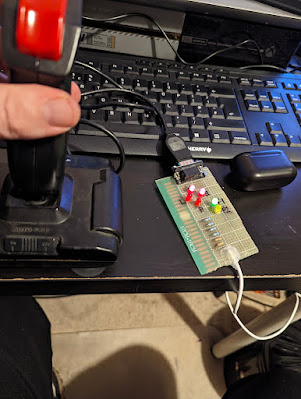Time for a bit of a break from the Torch's motherboard.
During my escapades with this computer I ended up plugging in the hard disk and floppy disk 'layer' as well as the motherboard just to check if it needed to have connection to a drive to boot (who knows with stuff this old!). Sadly, it didn't make a difference but it did show me that the hard disk actually started up and did not sound like a howling banshee. I'm looking at you, Cifer.
The main drive is a similar style to the Cifer drive and uses a stepper motor rather than coils to control the heads, as was the standard at the time. It spins up and makes some happy chirping noises. This is all a great sign but without the main computer up and running what can I do?
 |
| Hard disk, rear and centre. (Pic from last year before power supply shenanigans) |
*BlueSCSI2 has entered the chat* (as the kids might say)
The latest iteration of the amazing BlueSCSI project now has a fantastic function called 'initiator mode'. Now, I have not been a huge follower of this project but this new feature caught my eye as it said that it could read disks even without the host computer being available. Interesting...
And by coincidence, RMC happened to mention the BlueSCSI board and how to get them from the chaps at Flamelily IT. So an order went in and a couple of days later a parcel dropped through the door.
I went for the kit version that included a configured Pi Pico which is about £14 cheaper than a fully built unit. You could order a kit without a Pico too and save another £8. Anyway, building the unit was really straightforward and basically consisted of soldering on the right angle 50 pin SCSI connector, the power connector (like a floppy drive connector) and some pin headers. It genuinely took me less than half an hour to solder everything in. If I had any complaints it was that there is literally no documentation provided with the kit but given the limited soldering needed to build it I suppose that's not a major problem.
 |
| BlueSCSI raring to go.. |
Documentation to use the thing is available from the BlueSCSI github and it's also linked to from the Flamelily website.
First things first, to read a disk image I need an SD card (full size). Fortunately I have an 8Gb microSD and a gazillion adaptors to convert it to full size. This card needs to have a small file on it to tell the board to go into 'initiator' mode.
Next task. Get the jumpers in the right place. The unit in the Torch uses a standard SCSI 50 pin connector so it was as simple as plug it in to the BlueSCSI, insert the SD card, swap a couple of jumpers, apply power to the drive and the BlueSCSI and...
...nothing.
Ooops. In my haste I had missed one of the headers on the board that had to be set for 'initiator' mode. Install the header and stick a jumper on.
 |
| Target the initiator! Or something... |
 |
| Initiate! Initiate! |
Take 2.
The drive spun up and the Pico light began to flash, slowly at first but then it started to flash quickly and I could hear the drive heads moving. Nice! After a few minutes the flashing on the Pico went back to being slow and there was no more activity from the drive so I powered it all down.
Now, to see if there was anything viable on the card. First I looked at the log file and I could see that the drive responded to a query from the board on ID 7. Then a long list of data copying, sector by sector. Then, to my surprise, the drive also reported it had data on ID 0 and so the BlueSCSI copied that data too. I suspected that they were actually the same and it does seem to be a bit of a bug as per Adrian's Digital Basement video (released as I wrote this - spooky).
The upshot of this is that there are two .hda files on the SD card, each just over 40mb. This is great news as it means that we now have something we could possibly archive from the drive. To verify this I went and loaded one of the images into a hex editor and, sure enough, data is clearly visible.
But then I hit a snag. I decided to try and look at the files by mounting it in Linux. It did not work. It still does not work after several days of trying. I can only assume that there is something odd about the filesystem that modern systems don't like, even though the captured file is correctly identified as a 46Mb image with filesystem FAT16. Never mind. I do at least have the .hda files that should, in theory, be useable on a BlueSCSI in HDD mode once I get this thing up and running..
But wait, I have another full size SCSI drive. Perhaps I could get an image from this one too. Let's plug it in and see shall we?
Oh dear. Of course I knew it was dead before I took the lid off otherwise I would have just killed the drive myself. But it was gone. I dismantled it to see if I could find the damaged platter. The photo is just one of several that were damaged and is the only one I could get an anywhere OK photo of. For some reason trying to take pictures of highly polished surfaces is surprisingly hard!
 |
| Ring of death. |
And now, back to the motherboard... (next time).

















































